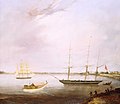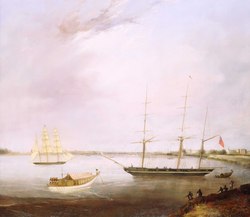File:The 'Streatham' and the opium clipper 'Red Rover' RMG BHC3580.jpg

Original file (4,013 × 3,481 pixels, file size: 4.03 MB, MIME type: image/jpeg)
| This is a file from the Wikimedia Commons. Information from its description page there is shown below. Commons is a freely licensed media file repository. You can help. |
Summary
| anonymous: The 'Streatham' and the opium clipper 'Red Rover'
|
||||||||||||
|---|---|---|---|---|---|---|---|---|---|---|---|---|
| Artist | ||||||||||||
| Author |
British School, 19th century |
|||||||||||
| Title | ||||||||||||
| Object type |
painting object_type QS:P31,Q3305213 |
|||||||||||
| Genre |
marine art |
|||||||||||
| Description |
English: The 'Streatham' and the opium clipper 'Red Rover' The ‘Streatham’ with the opium clipper ‘Red Rover’ are shown at anchor in the Hooghly River, Calcutta. The buildings of Calcutta dominate the skyline in the background. A local craft with passengers seen through the louvred canopy is being rowed from the ‘Streatham’. Figures on the shore on the right survey the scene and the nearest man appears to be fishing in the mighty river. Two thirds of the painting is sky which emphasises the vast scale of India. The ‘Streatham’ was a ship of the Honourable East India Company. The ‘Red Rover’ was the first and most famous of the purpose-built 'opium clippers' which carried opium from India to China. She was launched in Calcutta on 12 December 1829 and ran between Calcutta and the Pearl River. In 1846 she was bought by Jardine Matheson. Designed on the lines of fast American clipper ships, the ‘Red Rover’ doubled the profits of her owners by making two voyages a year from Calcutta to China. The ship was finally lost in the early 1870s. Opium was grown in large quantities in Bengal, and the East India Company had been granted the monopoly in trading the drug in 1773, and the right to grow it in 1793. By 1839, illegal opium sales to China were massive. In 1842, the Opium War came to an end after the signing of the Treaty of Nanking giving England control of Hong Kong. From this base of operations, opium smuggling grew with each passing year using these sleek opium clippers. Despite the early development of opium clippers in Indian and English shipbuilding yards, the British ship designers failed to adapt to the new need for speed. Their design habits had not changed from the years of the Napoleonic Wars, when the compulsory convoys had sailed at the speed of the slowest vessel. |
|||||||||||
| Date |
19th century date QS:P571,+1850-00-00T00:00:00Z/7 |
|||||||||||
| Dimensions | Painting: 1000 mm x 1162 mm; Frame: 1181 x 1342 x 45 mm | |||||||||||
| Collection |
institution QS:P195,Q7374509 |
|||||||||||
| Current location | ||||||||||||
| Accession number |
BHC3580 |
|||||||||||
| References | ||||||||||||
| Source/Photographer | http://collections.rmg.co.uk/collections/objects/15053 | |||||||||||
| Permission (Reusing this file) |
The original artefact or artwork has been assessed as public domain by age, and faithful reproductions of the two dimensional work are also public domain. No permission is required for reuse for any purpose. The text of this image record has been derived from the Royal Museums Greenwich catalogue and image metadata. Individual data and facts such as date, author and title are not copyrightable, but reuse of longer descriptive text from the catalogue may not be considered fair use. Reuse of the text must be attributed to the "National Maritime Museum, Greenwich, London" and a Creative Commons CC-BY-NC-SA-3.0 license may apply if not rewritten. Refer to Royal Museums Greenwich copyright. |
|||||||||||
| Identifier InfoField | id number: BHC3580 | |||||||||||
| Collection InfoField | Oil paintings | |||||||||||
Licensing
|
This is a faithful photographic reproduction of a two-dimensional, public domain work of art. The work of art itself is in the public domain for the following reason:
The official position taken by the Wikimedia Foundation is that "faithful reproductions of two-dimensional public domain works of art are public domain".
This photographic reproduction is therefore also considered to be in the public domain in the United States. In other jurisdictions, re-use of this content may be restricted; see Reuse of PD-Art photographs for details. | |||||
Captions
Items portrayed in this file
depicts
image/jpeg
File history
Click on a date/time to view the file as it appeared at that time.
| Date/Time | Thumbnail | Dimensions | User | Comment | |
|---|---|---|---|---|---|
| current | 20:28, 22 February 2020 |  | 4,013 × 3,481 (4.03 MB) | Broichmore | User created page with UploadWizard |
File usage
The following 2 pages use this file:
Global file usage
The following other wikis use this file:
- Usage on ca.wikipedia.org
Metadata
This file contains additional information, probably added from the digital camera or scanner used to create or digitize it.
If the file has been modified from its original state, some details may not fully reflect the modified file.
| Horizontal resolution | 72 dpi |
|---|---|
| Vertical resolution | 72 dpi |
| Software used | GIMP 2.10.14 |
| File change date and time | 20:20, 22 February 2020 |
| Color space | sRGB |


